
Catalog excerpts
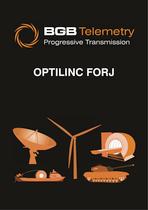
Optilinc FORJ
Open the catalog to page 1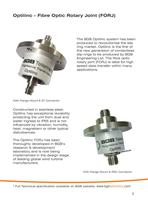
Optilinc - Fibre Optic Rotary Joint (FORJ) With Flange Mount & ST Connector Constructed in stainless steel, Optilinc has exceptional durability protecting the unit from dust and influenced by vibration, humidity, heat, magnetism or other typical The Optilinc FORJ has been thoroughly developed in BGB's research & development implemented in the design stage of leading global wind turbine The BGB Optilinc system has been produced to revolutionise the slip ring market. Optilinc is the first of slip rings to be produced by BGB Engineering Ltd. The fibre optic rotary joint (FORJ) is ideal for...
Open the catalog to page 3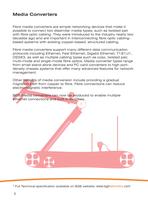
Media Converters Fibre media converters are simple networking devices that make it possible to connect two dissimilar media types, such as twisted pair with fibre optic cabling. They were introduced to the industry nearly two decades ago and are important in interconnecting fibre optic cablingbased systems with existing copper-based, structured cabling. Fibre media converters support many different data communication protocols including Ethernet, Fast Ethernet, Gigabit Ethernet, T1/E1/J1, DS3/E3, as well as multiple cabling types such as coax, twisted pair, multi-mode and single-mode fibre...
Open the catalog to page 4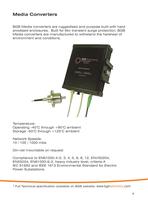
Media Converters BGB Media converters are ruggedised and purpose built with hard anodised enclosures. Built for 6kv transient surge protection, BGB Media converters are manufactured to withstand the harshest of environment and conditions. Temperature: Operating -40°C through +90°C ambient Storage -50°C through +125°C ambient Network Speeds: 10 / 100 / 1000 mbs Din-rail mountable on request Compliance to EN61000-4-2, 3, 4, 5, 6, 8, 12, ENV50204, EN55024, EN61000-6-2, heavy industry level, criteria A IEC 61850 and IEEE 1613 Environmental Standard for Electric Power Substations. * Full...
Open the catalog to page 5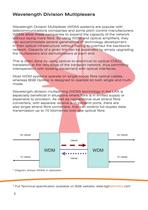
Wavelength Division Multiplexers Wavelength Division Multiplexer (WDM) systems are popular with telecommunications companies and some pitch control manufacturers. WDMs allow these companies to expand the capacity of the network without laying more fibre. By using WDM and optical amplifiers, they can accommodate several generations of technology development in their optical infrastructure without having to overhaul the backbone network. Capacity of a given link can be expanded by simply upgrading the multiplexers and demultiplexers at each end. This is often done by using...
Open the catalog to page 6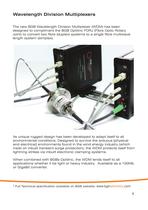
Wavelength Division Multiplexers The new BGB Wavelength Division Multiplexer (WDM) has been designed to compliment the BGB Optilinc FORJ (Fibre Optic Rotary Joint) to convert two fibre (duplex) systems to a single fibre multiwave length system (simplex). Its unique rugged design has been developed to adapt itself to all environmental conditions. Designed to survive the arduous [physical and electrical] environments found in the wind energy industry (which insist on inbuilt transient surge protection), the WDM protects itself from lightning strikes via inbuilt electronic clamping systems....
Open the catalog to page 7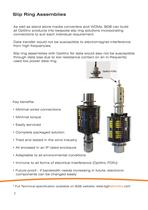
Slip Ring Assemblies As well as stand alone media converters and WDMs, BGB can build all Optilinc products into bespoke slip ring solutions incorporating connections to suit each individual requirement. Data transfer would not be susceptible to electromagnet interference from high frequencies. Slip ring assemblies with Optilinc for data would also not be susceptible through data loss due to low resistance contact on an in-frequently used low power data ring. Key benefits: • Minimal wired connections • Minimal torque • Easily serviced • Complete packaged solution • Tried and tested in the...
Open the catalog to page 8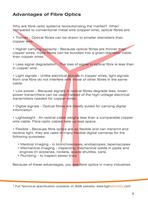
Advantages of Fibre Optics Why are fibre-optic systems revolutionising the market? When compared to conventional metal wire (copper wire), optical fibres are: • Thinner - Optical fibres can be drawn to smaller diameters than copper wire. • Higher carrying capacity - Because optical fibres are thinner than copper wires, more fibres can be bundled into a given-diameter cable than copper wires. • Less signal degradation - The loss of signal in optical fibre is less than in copper wire. • Light signals - Unlike electrical signals in copper wires, light signals from one fibre do not interfere...
Open the catalog to page 9
Email: mail@bgbinnovation.com BGB Innovation and BGB Telemetry are trading styles of BGB ^Engineering Ltd. Dysart Road, Grantham, Lincolnshire NG31 7NB UK
Open the catalog to page 12All BGB Innovation catalogs and technical brochures
-
Optilinc
1 Pages
-
120 Amp Brush Holder
2 Pages
-
PARATEC Brush Holders
1 Pages
-
Wind Industry Brochure
20 Pages







